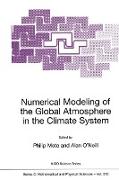- Start
- Numerical Modeling of the Global Atmosphere in the Climate System
Numerical Modeling of the Global Atmosphere in the Climate System
Angebote / Angebote:
21. Simulating Future Climate G. J. Boer 1 Introduction. . . . . . . . . . . . . . . . 489 2 International Aspects . . . . . . . . . . . 490 3 Simulating Historical and Future Climate 492 4 Climate Change in the 20th Century . . . 495 5 Simulating Future Climate Change 498 6 Climate Impact, Adaptation, and Mitigation 501 7 Summary . 502 Index 505 PREFACE Numerical modeling ofthe global atmosphere has entered a new era. Whereas atmospheric modeling was once the domain ofa few research units at universities or government laboratories, it can now be performed almost anywhere thanks to the affordability of computing power. Atmospheric general circulation models (GCMs) are being used by a rapidly growing scientific community in a wide range of applications. With widespread interest in anthropogenic climate change, GCMs have a role also in informing policy discussions. Many of the scientists using GCMs have backgrounds in fields other than atmospheric sciences and may be unaware of how GCMs are constructed. Recognizing this explosion in the application of GCMs, we organized a two week course in order to give young scientists who are relatively new to the field of atmospheric modeling a thorough grounding in the basic principles on which GCMs are constructed, an insight into their strengths and weaknesses, and guid ance on how meaningful numerical experiments are formulated and analyzed. Sponsored by the North Atlantic Treaty Organization (NATO) and other institu tions, this Advanced Study Institute (ASI) took place May 25-June 5, 1998, at II Ciocco, a remote hotel on a Tuscan hillside in Italy.
Folgt in ca. 5 Arbeitstagen

